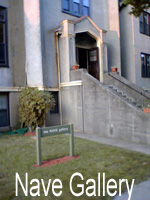
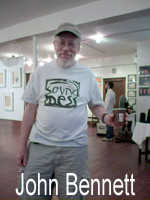
Raves for Nave Gallery.
Their Sound Vision/ Vision Sound 111 International Exhibition and Festival of Verbo -Visual Artwork and Performances were wonderful.
I attended the performance on July 15th and was struck by the artwork, the intimate space, and the cozy atmosphere
of the gallery. I went to see John M. Bennett and Be Blank Consort perform. I also wanted to meet John because
for years I've been reading his work which I love. Be Blank Consort performed many pieces which took on language
in a new way. Many of the poems were spoken simultaneously with performers speaking different text. It gave a
chorus effect. I found myself listening to some text but then my attention would go to another person and what
they were saying. The rhythm and structure of the text allowed the listener to make their own meaning at times.
The pieces that really stood out for me were Lungs, P piece, and a brilliant performance and delivery of
The Peel Peeled.
This last piece was performed in three different languages at the same time. The timing and delivery of all
the work was well crafted. Be Blank Consort knew exactly what they were doing. Other members of the group that
performed were K.S.Ernst, Scott Helmes and Michael Basinski. All of the performers were wonderful. I just loved it!
I wondered if they put any of their pieces together like John Cage used to do. That is throwing up notes in the
air and putting them together in random order. Years ago, I saw a special on PBS on John Cage. Richard Kostelanetz,
a language poet, spoke about him on this special. I considered everyone that night performing to be language poets. The text was not only important on the delivery but also how it looked on the page.
I cannot rave enough about this group.
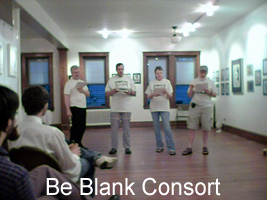
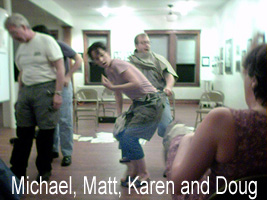
BuffFluxus was the next to perform, the performance group was established
in 1956 when they first performed on the Ed Sullivan show. They were great. They also experimented with language,
text, and delivery. They consisted of members Michael Basinski, Doug Manson, Matt Chambers and Karen Yocobucci.
They did a Poem Improvise, in which a box of pants/shorts were emptied out onto the floor. They called them
John M. Bennett's pants. They put them on and audience members could do the same if they wanted to. Another piece they
did I'll call Oh Shit. In this, they said the phrase in as many different ways that one possibly could. It was
hysterical. I laughed quite a bit over this one. I am not sure if that was the actual name so forgive if it's
wrong. Also the audience took part in the beginning of one piece where they were asked questions. These
performers were just wonderful. Their delivery and pieces performed added another layer of text performance
art into the night.
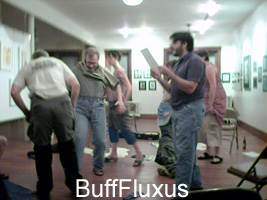

The last group consisted of three performers, Chris Fritton, William R. Howe and Lisa Phillips.
It started with a huge blank piece of white paper on the floor. On the sides of the paper were ink pads.
The performers stepped on them and walked on the paper. Different letters came out onto the paper. While
doing this they made sounds. The whole experience was fascinating to watch. Visually watching printing and
listening to sounds were again showing the audience members the different way text and printing can affect us.
It was like watching an installation piece coming to life. Also the ink on paper came off their shoes with
different texture which added depth to the piece. All this layering by all performers gives us a new insight
to how important language and text is. Why not take it to new levels? Everyone here definitely did that.
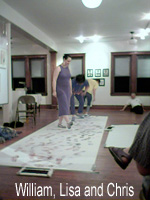
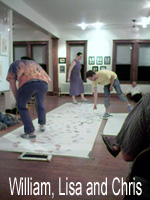
William R. Howe who is Curator of the gallery put together a wonderful and I do mean a wonderful exhibition and
performances. It took such work on his part. What a show to put together. His Assistant Curators, Chris Fritton
and Lisa Phillips are to be commended for their huge part also. It was a great night of visual, sound,
text/language and performance art put together.
Raves to Nico Vassilakis and the screening of his shorts. Visually beautiful
to watch. He is a brilliant writer so this was really neat for me to see.
The exhibition at the Nave Gallery is open until Aug. 6th.
One can look forever at the exhibitions. Again, just visual stunning. Do see this if you're in the area.
On a final note, everyone who I spoke to from performers to audience members, were just gems. Everyone
was so nice and the performers were all genuinely interested in feedback from the show.
I have Raves for them all, so Thank you.

|
|
Poet Catherine Sasanov is the author of Traditions of Bread and Violence
(Four Way Books) and All the Blood Tethers (Morse Poetry Prize, Northeastern University Press).
She is also the librettist for Las Horas de Belén: A Book of Hours, a theater piece commissioned by
Mabou Mines. Her recently released chapbook, What's Left of Galgani, is a selection of work from the
poem cycle, Reassembling the Bodily Relics of St. Gemma Galgani. It was
published in 2004 by Franciscan University Press, Steubenville, Ohio. Her poem, "Day of the Dead: La Dulcería de
Celaya," will be part of the Červená Barva postcard series.
Describe the space you write in.
For 14 years I didn't have a room of my own unless I went off to an artists' colony. There, for four or five weeks,
I would have my own space. Sometimes a little cottage, sometimes a small room with paper thin walls, but by God,
it was mine and stripped of all distractions. I owe so many of these places - MacDowell, Hedgebrook, Blue Mountain
Center, and the Millay Colony in particular - for giving me the gift of time and space when I didn't have much of
either.
It was only in the fall of 2003 that I got my own room again, when my boyfriend's brother rented out the
first floor of his triple decker to Paul and I. So I now write in a very comfy, very ugly wingback chair wedged
into the farthest corner back in the farthest room away from the front of the house.
I sometimes feel like I walk
in the front door, all the way to the back of the house, pulling the rest of the world in after me. In the last
10 years I have spent a fair amount of time following one obsession or another to Mexico City or Europe, and the
tangible things I drag back (photos, notes, interviews, books, objects, gifts) end up on the walls, in the
bookshelves, or strewn over three desks while I try and interpret what it all means through my poems. Some of
these are packed away when the obsession burns itself out; others find a more permanent place in my studio.
Surrounding me now: a two foot tall devil lording over the room, directly across from a Virgin of Guadalupe given
to me by my hero, writer Elena Poniatowska. A papier mache skull fitted by artist Jane Wiley with a baby's red
knit cap and scarf. A cabinet of talismans: miracle dirt from Chimayo, a bottle of I can bear more than you
liquid given to me by a follower of Mexican folk healer Niño Fidencio, two wooden figas (good luck shaped like a
fist) from Brazil, a small statue of La Santa Muerte (St. Death) bought at her shrine in Tepito, and five
wishbones I discreetly plucked from various chicken breasts when I lunched at The Glass of Milk, Vaso de Leche,
during an extended stay in Mexico City. Scattered elsewhere in the room: my mother's collection of carved
wooden monks; a ceramic bowl of locket relics holding the blood, dust, and bone of a few saints; a velvet
bag bearing about a half cup of my mother's ashes, and the photos and memorial cards of friends dead and living.
All of these things circle the business end of a writing life: paper, pens, computer, printer, wastebasket.
Until I was laid off in May of this year, I knew this room best between 2 or 3 a.m. and 7 a.m., the hours I
staked out for writing before leaving for my 9 to 5 job. So there was always intense silence in this space,
me sitting in a pool of light from one lamp, and visits from a little mouse who would show up during the coldest
months.
What are you working on now?
Since my obsessions tend to choose my subjects, the question might be more appropriately phrased as What's
working on Catherine now? A few of my obsessions (the dead, Catholicism, Mexico City) all converged earlier
this year around the figure of La Santa Muerte, Most Holy Death or St. Death, a skeleton raised up and prayed
to in the very dicey neighborhood of Tepito in Mexico City. The Catholic church rails against her, but that
hasn't stopped people from making pilgrimages to Santa Muerte's shrine and asking favors of her the way one
might ask favors of the Virgin Mother. For a long time, she was worshipped very clandestinely, mostly by
persons who lived lives close to death: prostitutes and thieves, for example. Her draw is that she is totally
unjudgemental, totally amoral. One can ask her for assistance in finding work, getting well, holding a marriage
together. At the same time, one can ask her for help in killing someone off or robbing a bank. It's all the same
to her. I was fortunate to get into Tepito and her shrine earlier this year, particularly fortunate since
I was able to join up with some people who got me safely in and out. As long as I kept my wits about me,
I used to be able to wander Mexico City alone without too much trouble. In recent years, though, the city
has become rampant with kidnapping, and even during the hours I was at the shrine, someone was kidnapped
two blocks over. Death personified is not something I have really dealt with in my work; till visiting this
shrine and talking to Santa Muerte's followers, death was the wind: a thing I could see only when it moved
through someone or something else. And this Death, this saint of last resort, is about the furthest thing
imaginable from the humorous skeletons and skulls Mexico produces during the Day of the Dead.
Anyway, I'm doing what I usually do, just letting my obsession thread a ring through my nose and lead me where
it wants. One of the poems coming out of all this, "Give Me My Little Skull: Joel Peter Witkin, Mexico City," will be published around Christmas 2005 in the journal Skidrow Penthouse. Another of the poems will
be part of the postcard series Cervená Barva press is publishing.
Where do you find inspiration for your writing?
I've been fortunate, this far in life, not to have had to look for things to write about.
They tend to find me or I stumble over them. Poetry is something of a candle I lean into the dark with;
it lights up the things I don't understand.
What is the strangest thing you've done to find writing material?
Most of my writing comes out of strange things that happen to me, or within eyeshot, that later
provoke a poem. Like finding out months after the fact that I'd stood on Josef Mengele's still
undiscovered grave in Brazil. Or seeing Death throned and peeking out of a pile of marshmallows in a
wicker basket in Mexico City. I've learned that even the tiniest, mundane gesture at the right time,
in the right place, can trigger something, like simply lifting the sheet from my dead boyfriend's body
only to find the chest cracked open, ribs hauled back, and heart exposed.
I guess I have done some odd things, though, when I have gone looking for a deeper understanding of a
subject that's gotten its hooks in me. People would probably find it strange to be making a concerted
effort to track down Death's street address, then fly down to Mexico City to pay her a visit. For four
years I was working on a poem cycle having to do with an obscure Catholic saint, Gemma Galgani of Lucca, Italy.
In trying to understand her, a stigmatic prone to visions of Jesus, Mary and her Guardian Angel, I became even
more involved in learning about her family. The repercussions of Gemma's sanctity were often brutal on them,
and after Gemma's death the family's reputation was pretty much chewed up and spit out as it got sucked up into
the canonization process. I went to Lucca searching for the saint's descendents and those who knew those who
knew Gemma. Probably one of the strangest and most wonderful moments was being in a house Gemma had lived in,
sitting with her grand niece and nephew around a table the saint had dined at daily, while three elderly nuns
told us unpublished details about Gemma and her family, the gossip still fresh after 100 years. In the middle
of the table, encased in its silver reliquary, one of the nuns had left a chunk of Gemma's heart so she could
be there with us.

|

